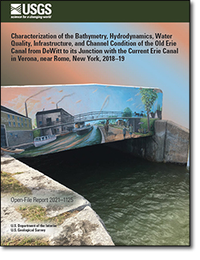Characterization of the Bathymetry, Hydrodynamics, Water Quality, Infrastructure, and Channel Condition of the Old Erie Canal from DeWitt to its Junction with the Current Erie Canal in Verona, near Rome, New York, 2018–19
Links
- Document: Report (94.4 MB pdf) , HTML , XML
- Data Release: USGS data release - Geospatial dataset of the characterization of the bathymetry, hydrodynamics, water quality, infrastructure, and channel condition of the Old Erie Canal from DeWitt to Rome, New York 2018–2019
- Download citation as: RIS | Dublin Core
Abstract
The Old Erie Canal has undergone sedimentation and aquatic growth that have restricted flow and diminished the aesthetic quality of the canal during the nearly 200 years since its construction. During 2018–2019, the U.S. Geological Survey (USGS) in cooperation with the Madison County Planning Department and the New York State Canal Corporation conducted a study of the Old Erie Canal between the Town of DeWitt, New York, and its junction with the current Erie Canal of the New York State Canal System near Rome, N.Y. The study comprised bathymetric, velocity, and water-quality surveys and documentation of the canal infrastructure. The USGS established benchmarks and staff gages along the 30.8 miles of the canal study area to reference the water-surface level in the canal to the North American Vertical Datum of 1988 (NAVD 88). Bathymetric survey results indicated that during the time of the survey, the canal depths ranged from 1.26 feet (ft) to 7.33 ft between the Butternut and Durhamville aqueducts (with a mean depth of 3.52 ft). Shallow depths are located throughout the canal, but the section north of the Durhamville aqueduct was the shallowest, with depths ranging from 0.68 ft to 2.44 ft (and a mean depth of 1.36 ft). The reach-averaged water velocity was 0.28 feet per second. The system generally flows west to east from the Butternut aqueduct to the entrance to the Erie Canal.
Water-quality data (dissolved oxygen, water temperature, specific conductance, pH, and turbidity) were collected concurrently with the bathymetric survey (spring 2018) to characterize changes in water quality along the length of the canal. Specific-conductance values measured upstream from the hamlet of Kirkville, Manlius, N.Y. may reflect road salts being flushed into the canal through the Butternut and Limestone feeder system (designed to divert water from nearby creeks to supply water for the Old Erie Canal) from recent stormwater runoff. Increases in pH in the downstream direction are possibly caused by increasing amounts of aquatic vegetation. During the time of the survey, turbidity was highest near inflows from the canal feeder system and tributary inputs which were elevated by stormwater runoff that transported sediment into the canal.
The canal infrastructure was documented to provide a baseline assessment. The feeder system, designed to bring water into the canal, does not deliver flow when the creeks supplying water to those feeders are at base flow, but does bring water into the system when flows in the feeder creeks are elevated. A recent report provides an example of repair work completed on the Chittenango feeder to improve flow through the feeder into the canal (Welch and Madison County Planning Department, 1996). Two non-regulated tributaries, Meadow Brook and Pools Brook, consistently delivered flow to the canal. Outfalls where canal water discharges into nearby creeks were sealed in the Butternut and Limestone aqueducts. Outfalls in the Chittenango, Cowaselon, and Durhamville aqueducts were found with flashboards installed at an elevation that allows water to be discharged from the canal. These structures are designed to accept additional flashboards to raise the canal water surface with the potential to convey flow farther down the system. The general condition of the channel was open and navigable between Butternut aqueduct and Chittenago aqueduct. On the segment of the canal east of the Chittenango aqueduct, an increasing number of downed trees and tangled wads of vegetation affected flow and made navigation by boat difficult to the Durhamville aqueduct. North of the Durhamville aqueduct, numerous downed trees and an increased density of aquatic vegetation limited navigation by boat and reduced the flow rate.
Suggested Citation
Wernly, J.F., 2022, Characterization of the bathymetry, hydrodynamics, water quality, infrastructure, and channel condition of the Old Erie Canal from DeWitt to its junction with the current Erie Canal in Verona, near Rome, New York, 2018–19: U.S. Geological Survey Open-File Report 2021–1125, 75 p., https://doi.org/10.3133/ofr20211125.
ISSN: 2331-1258 (online)
Study Area
Table of Contents
- Acknowledgments
- Abstract
- Introduction
- Study Area
- Methods
- Survey Results
- Observations of the General Condition of the Canal Infrastructure and Channel
- Summary
- References Cited
- Appendix 1. Old Erie Canal Benchmark Establishment Forms
- Appendix 2. Old Erie Canal Staff Gage and Benchmark Locations
- Appendix 3. Feeder System and Inflows of Old Erie Canal
- Appendix 4. Aqueducts and Outfalls of Old Erie Canal
| Publication type | Report |
|---|---|
| Publication Subtype | USGS Numbered Series |
| Title | Characterization of the bathymetry, hydrodynamics, water quality, infrastructure, and channel condition of the Old Erie Canal from DeWitt to its junction with the current Erie Canal in Verona, near Rome, New York, 2018–19 |
| Series title | Open-File Report |
| Series number | 2021-1125 |
| DOI | 10.3133/ofr20211125 |
| Publication Date | July 12, 2022 |
| Year Published | 2022 |
| Language | English |
| Publisher | U.S. Geological Survey |
| Publisher location | Reston, VA |
| Contributing office(s) | New York Water Science Center |
| Description | Report: viii, 75 p.; Data Release |
| Country | United States |
| State | New York |
| Other Geospatial | Old Erie Canal |
| Online Only (Y/N) | Y |
| Additional Online Files (Y/N) | N |


